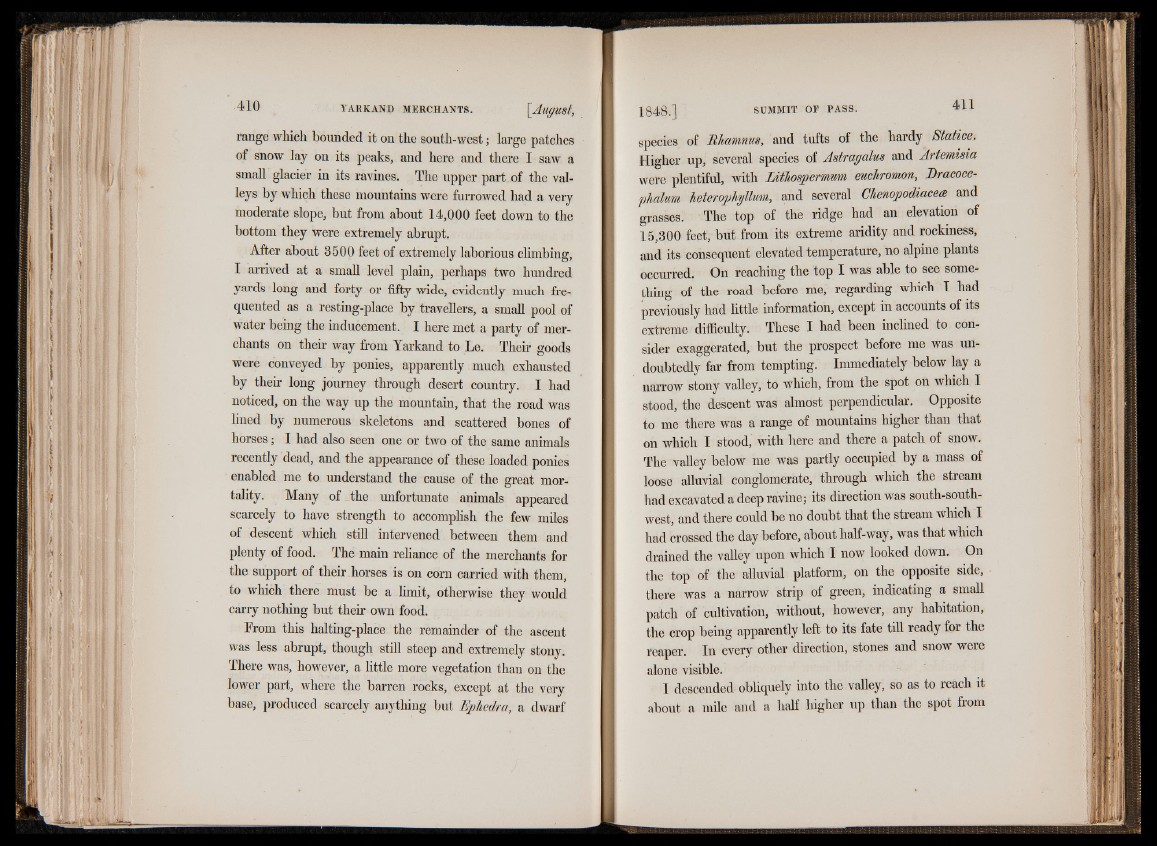
range which bounded it on the south-west; large patches
of snow lay on its peaks, and here and there I saw a
small glacier in its ravines. The upper part of the val-
leys by which these mountains were furrowed had a very
moderate slope, but from about 14,000 feet down to the
bottom they were extremely abrupt.
After about 3500 feet of extremely laborious climbing,
I arrived at a small level plain, perhaps two hundred
yards long and forty or fifty wide, evidently much frequented
as a resting-place by travellers, a small pool of
water being the inducement. I here met a party of merchants
on their way from Yarkand to Le. Their goods
were conveyed by ponies, apparently much exhausted
by their long journey through desert country. I had
noticed, on the way up the mountain, that the road was
lined by numerous skeletons and scattered bones of
horses; I had also seen one or two of the same an ima ls
recently dead, and the appearance of these loaded ponies
enabled me to understand the cause of the great mortality.
Many of the unfortunate animals appeared
scarcely to have strength to accomplish the few miles
of descent which still intervened between them and
plenty of food. The main reliance of the merchants for
the support of their , horses is on com carried with them,
to which there must be a limit, otherwise they would
carry nothing but their own food.
Prom this halting-place the remainder of the ascent
was less abrupt, though still steep and extremely stony.
There was, however, a little more vegetation than on the
lower part, where the barren rocks, except at the very
base, produced scarcely anything but Ephedra, a dwarf
species of Bhamnus, and tufts of the hardy Statice.
Higher up, several species of Astragalus and Artemisia
were plentiful, with Litlospermum euchronwn, Dracoce-
phalurn heterophyllum, and several Chenopodiacece and
grasses. The top of the ridge had an elevation of
15,300 feet, but from its extreme aridity and rockiness,
and its consequent elevated temperature, no alpine plants
occurred. On reaching the top I was able to see something
of the road before me, regarding which I had
previously had little information, except in accounts of its
extreme difficulty. These I had been inclined to consider
exaggerated, but the prospect before me was undoubtedly
far from tempting. Immediately below lay a
narrow stony valley, to which, from the spot on which I
stood, the descent was almost perpendicular. Opposite
to me there was a range of mountains higher than that
on which I stood, with here and there a patch of snow.
The valley below me was partly occupied by a mass of
loose alluvial conglomerate, through which the stream
had excavated a deep ravine; its direction was south-south-
west, and there could be no doubt that the stream which I
had crossed the day before, about half-way, was that which
drained the valley upon which I now looked down. On
the top of the alluvial platform, on the opposite side,
there was a narrow strip of green, indicating a small
patch of cultivation, without, however, any habitation,
the crop being apparently left to its fate till ready for the
reaper. In every other direction, stones and snow were
alone visible.
I descended obliquely into the valley, so as to reach it
about a mile and a half higher up than the spot from